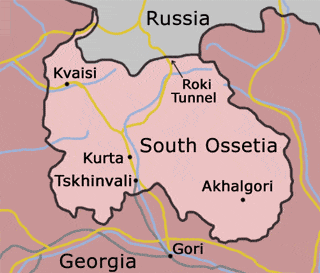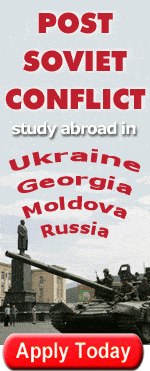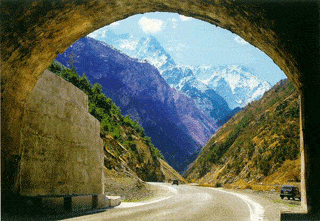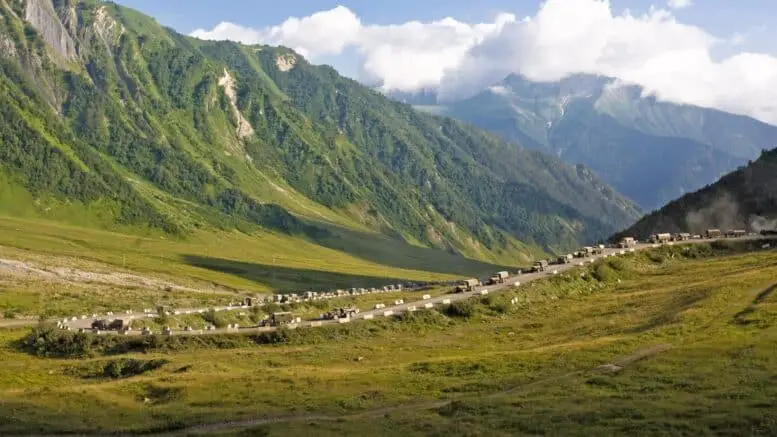South Ossetia is one of the world’s newest independent states according to Russia, Nicaragua, Venezuela, and the microstates of Tuvalu and Nauru. According to all other states and international organizations, South Ossetia is an autonomous region of Georgia, functioning as a de-facto state for the last twenty years after declaring independence and fighting a successful armed rebellion.

Geography and transport make South Ossetia’s position difficult. All rail lines (gray) and rivers (blue) lead to Georgia. For overland transport, South Ossetia is effectively dependant on one small road (yellow) leading through its northern mountains into Russia
Despite a tiny population and its geographically tenuous position crushed into a land-locked, mountainous land between the two larger states of Russia and Georgia, South Ossetia has shown a tenacious will to survive.
South Ossetian Geography and Demographics
South Ossetia occupies a series of valleys on the southern slopes of the main range of the Caucasus Mountains. Approximately 1,500 square miles large, South Ossetia has a population of only 55,000, most of which live in Tskhinvali, the capital city. Elsewhere, settlements are largely limited to small villages with little economic activity apart from subsistence agriculture.
The region has traditionally had mixed communities of ethnic Georgians and Ossetians, although, in the wake of secession and the subsequent wars, many of the ethnic Georgians have left the territory. There are also small communities of Russians and Armenians. South Ossetia is almost wholly Orthodox Christian, with very small minorities of Jews and Muslims. The entire region is desperately poor, with what little economic activity that existed before now largely extinguished by two recent wars and decades of isolation. At present, all gas, electricity, and large quantities of foodstuffs are imported from Russia, while almost all Ossetians wanting to receive a higher education must go to Russia to study.
Early History of South Ossetia
The people now known as the Ossetians are believed to have moved to the region encompassing South Ossetia and North Ossetia (a territory in Russia) during the 13th century. The Ossetians were previously known as “Alans,” which was one of many variations of the name “Iran” and “Arayan” that once referred to many related tribes of Persian-speaking pastoral nomads that stretched from Africa to Asia. The Alans came to be known as the “Osi” in Georgian, from which their modern name is drawn.

South Ossetia’s north and its border with Russia are dominated by rugged mountains. The region has little agricultural land and few water resources to support it.
The Alans initially resided primarily on the plains north of the Caspian Sea, with some tribes ranging as far east as the Aral Sea. The Alans gradually moved westwards, moving to an area around the Don River by the 1st century BC. From this base, the Alans frequently raided deep into Europe, harrying Roman territories in the Balkans and the Caucasus. The arrival of the Huns in the late 4th century AD forced them to leave this homeland and move south towards the protection of the North Caucasus Mountains. Additionally, many Alans joined the army of the East Germanic Vandals and helped invade the Western Roman Empire in the fifth century, settling in territories such as Gaul, Hispania, and North Africa.

Alania was destroyed by the Mongols in 1230, and the surviving Alans fled deeper into the Caucasus Mountains, settling in the area now known as North Ossetia, with some fleeing further into South Ossetia, at that time part of the Kingdom of Georgia. The Kingdom of Alania revived for a time after the Mongol invasion, but was once more crushed in the 14th century by the Timurids, a Sunni Muslim dynasty of Turco-Mongol lineage that controlled large parts of Central Asia and the Caucasus in the Late Middle Ages and Early Modern periods.
After this, political power in the Ossetian region was largely fragmented and weak until the area was annexed by the Russian Empire, starting with North Ossetia in 1767 and extending to South Ossetia with the rest of Georgia in 1801. Absorption by the Russian Empire brought some development and also the arrival of the railroad to North Ossetia, yet South Ossetia remained relatively poor and undeveloped.

View from the Roki Tunnel, which helps support a small two-lane highway through the Caucauses and is one of the few passes through that mountain chain. It was completed in 1985.
Post-Revolution Ossetia
After the Russian Revolution, South Ossetia became part of the short-lived Georgian Democratic Republic. Relations between Georgians and Ossetians greatly deteriorated in this period, as the Georgian government accused ethnic Ossetians of collaborating with the Bolsheviks. A series of riots and rebellions broke out between 1918 and 1920 as South Ossetians resisted the new Georgian government, and Georgian soldiers were deployed to the area to restore order. Some Ossetians claim that as many as 5,000 Ossetians died in these clashes, and that over twice that number died from starvation and disease which resulted from the civic disorder.
In 1921, the Red Army invaded Georgia, putting an end to the Georgian Democratic Republic. North and South Ossetia continued to be considered separate territories as they were incorporated into the Soviet Union; North Ossetia was absorbed by the Russian SSR and South Ossetia was made an autonomous oblast within first the Transcaucasian SFSR and then the Georgian SSR. In the Soviet Union, South Ossetia saw considerable development, with the construction of a railway to Gori in Georgia and significant construction in Tskhinvali. The Ossetians also were granted considerable autonomy in this time period; Ossetian was their official language and the language of instruction in schools.
Perestroika and Post-Soviet Ossetia
Georgians and Ossetians coexisted peacefully for most of the Soviet period, yet as the Soviet Union began to fall apart tensions reappeared. In 1989, the South Ossetian government requested that the Georgian government upgrade the oblast to an autonomous republic. Not only did the Georgians deny this request, they established Georgian as the official language throughout the Republic of Georgia, including South Ossetia, and, in 1990, barred regional political parties from taking part in elections.
This led to South Ossetia proclaiming the South Ossetian Democratic Republic, which was to be an autonomous region within the Soviet Union. The South Ossetians boycotted Georgian elections and instead elected their own government. The situation worsened when Zviad Gamsakhurdia, a prominent Georgian nationalist, was elected president of Georgia in 1990. Gamsakhurdia quickly declared the Ossetian elections illegitimate and moved to abolish South Ossetia’s autonomous status altogether, declaring Ossetians to be “newcomers” in Georgia and saying they had no right to autonomy.
Violent conflict between Georgians and Ossetians broke out in late 1990, and, in January of 1991, the Georgian military entered South Ossetia, resulting in the first Georgian-Ossetian war. Both sides claimed that atrocities were committed by the other. The region was stabilized by the arrival of Soviet Interior Troops in the spring of 1991, but tensions remained and the territory’s status was left undecided.
The problems in South Ossetia were only a fraction of the ethnic, political, and economic problems that Gamsakhurdia and his government faced at the time. Towards the end of 1991, these mounted and resulted in a coup that unseated Gamsakhurdia and led to Eduard Shevardnadze’s rise to power. Shevardnadze’s first priority was to restore order within Georgia, and retaking South Ossetia was made a fairly low priority. Russia, which had taken an interest in the independence of South Ossetia early on, helped to negotiate a ceasefire between South Ossetia and Georgia that left the region largely independent, but with large parts of territory still occupied by Georgian troops. Russia also stationed a peacekeeping force on South Ossetian territory at this time.
This status quo lasted nearly 15 years. In the meantime, Georgia
Georgia created a puppet government in South Ossetia and sent soldiers to try to crack down on smuggling and black market activities in the quasi-state. These more aggressive policies resulted in several border conflicts. Finally, in August of 2008, a force of approximately 15,000 Georgian soldiers invaded South Ossetia, supposedly in response to the Ossetian bombardment of Georgian-controlled villages. The Georgian military pushed back the Ossetians, but were slowed by heavy fighting in Tskhinvali and were unable to seize the Roki tunnel before significant Russian reinforcements could cross from the north. The arrival of the Russian military had been expected as Russia’s role as a peacekeeper in the ceasefire agreement assumed that Russia would take actions to enforce the status quo.
The Georgians were quickly pushed back and the Russians moved not only into all of South Ossetia, but also seized large portions of the Republic of Georgia. While the Russian military pulled out of Georgian territory in the ensuing French-brokered cease-fire, they maintained a large force within South Ossetia, which was expanded to include all of the territory of the former Autonomous Oblast of South Ossetia.
Russia additionally proclaimed that it recognized the region as an independent country, which allowed new trade routes to be opened between Russia and South Ossetia and for Russia to expand its diplomatic and aid networks in the country. Russia has also issued passports to South Ossetians, allowing them to travel.
While few other countries followed suit, Russia’s recognition of South Ossetia will make reintegration of the territory with Georgia, which remains a Georgian diplomatic priority and is supported by most of the international community, considerably harder. It also strengthens Russia’s military and diplomatic power in the Caucasus, which makes states like Georgia nervous.
There was much speculation that South Ossetia would enter the Russian Federation and be combined with North Ossetia, though the South Ossetian government as well as the Russian Federation vigorously denied these claims. Russia has greatly enlarged its peacekeeping forces in the region, making it increasingly unlikely that South Ossetia will ever be reunited with Georgia. At present, South Ossetia remains a precariously independent quasi-state, albeit with slightly more breathing room.
Modern South Ossetia
Since its secession, South Ossetia has governed itself as a democracy, holding regular elections which, though unrecognized by the outside world and marred by voter fraud, have at least resulted in regular transfers of power and the upset of several incumbents.
Its most recent elections were held in 2011-2012. Alla Dzhioyeva, a former education minister under Eduard Kokoity, the outgoing president at the time, was declared the winner of the 2011 presidential election. She had previously been fired by Kokoity, found guilty of fraud and official misconduct, and later became a strong critic of Kokoity. However, she also remained pro-Russia and anti-Georgia.
After the elections, The Supreme Court declared the results invalid due to electoral fraud. An additional bar on her participating in a new round of elections was eventually lifted, however, she mysteriously withdrew her candidacy and was later hospitalized for “hypertension” after her office was raided by police. The elections were eventually won by Leonid Tibilov in 2012. Tibilov remains the president and is a former KGB official and strong supporter of close ties with Russia.
With a tiny population and virtually no domestic resources, South Ossetia is still struggling to overcome years of war and decades of being cut off from the wider international community. It has no significant exports and relies heavily on Russian aid and imports. Most of its few factories, all built during the soviet era, are idle, lacking the workforce and capital to bring them online again. Most of the region’s prospects, and those emphasized by its leaders as they lobby for investment at Russian trade shows, concentrate on the same agricultural products for which Georgia is also famous: mineral water, wine, and cheese.
However, so long as South Ossetia is not recognized by the larger international community – or reabsorbed into a recognized political body – its prospects remain extremely limited. However, its will to survive seems to remain boundless.




